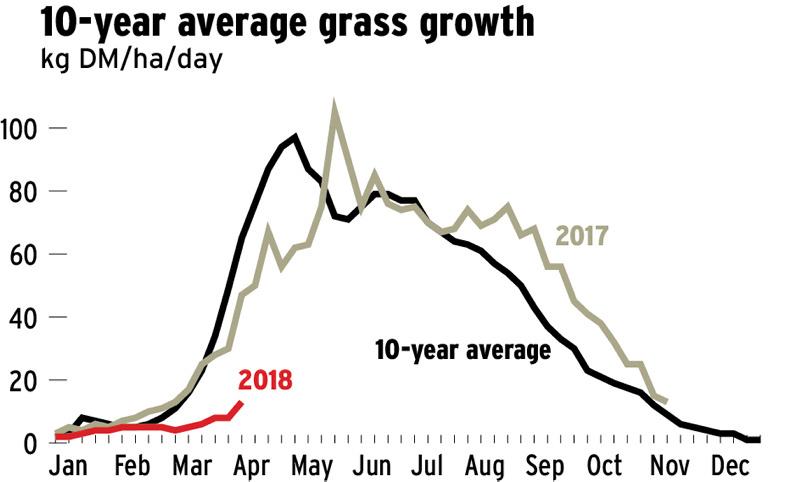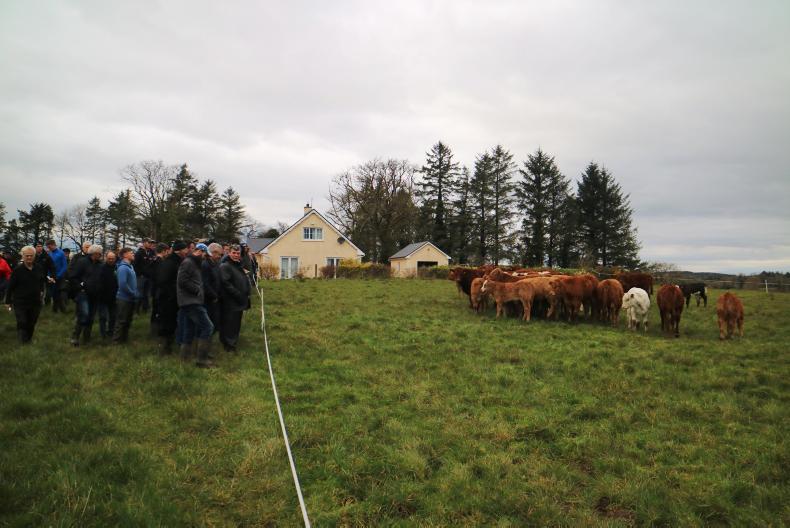Our measuring farms recorded an average of 10kg DM/ha/day of growth since last week. This isn’t much of a change on recent weeks unfortunately, but there is a definite lift towards the 20s evident on the grass walks that were logged in recent days. Current forecasts point toward a mild weekend with some rain and then a lift in temperature for next week. This should bring a burst of growth.
To capitalise on growth as quickly as possible, we would ideally have 10 days’ worth of grass on our grazing ground (farm cover of 500kg on a farm stocked at 2.5LU/ha) and be grazing covers no lighter than 8cm. To stretch this out we could consider supplementing with concentrates or silage, or grazing a small section of silage ground until growth picks up. We need to be moving with nitrogen fertiliser as soon as ground is trafficable too.
I am of the firm belief that while higher-stocked beef farms and dairy farms will find it very tight to fully replenish their fodder stocks this growing season, the typical Irish drystock farm has huge scope to grow most of all of their own reserves from inside their walls this winter. Why? Because prevailing stocking rates are low enough that once growth does finally pick up these farms will quickly find themselves in a grass surplus. Indeed, in a normal April grass would be starting to get ahead of many farmers by now.

Measuring our grass supply weekly will reap dividends in two ways – by maximising the feeding value of the material being grazed (there can be up to 20% of an energy difference between leaf and stem) and by producing a warchest of unplanned silage bales. On this week’s BETTER farm page, we chronicle how Brian Doran took 330 bales from his grazing ground on top of his main cuts and these have been vital to him during the recent fodder shortage. He was able to make these by quadrupling the amount of divisions on his farm and by measuring covers weekly so that he knew, with peace of mind, when to graze and when to take out bales.
If you would like information on measuring your grass, send us an email or look at our YouTube channel.

Co Cork
System suckler/calf to beef
Soil type relatively dry
Farm cover (kg DM/ha) 279
Demand (kg DM/ha/day) 14
Growth (kg DM/ha/day) 7
I have cows grazing on the odd dry day we get in order to spare my silage. I have been out of silage for a few weeks but have been able to source bales of straw and silage from different areas so far. Land is very wet here even though my farm is a relatively free-draining one overall.
I plan to spread urea at a rate of 40 units/acre as soon as ground conditions allow to try get back on track with growth.
Temperatures are starting to rise but my average farm cover is very low. It will take some time for me to recover my grass covers to a sustainable level as I have a high demand.
I have bulls coming near slaughter in the next month and these sales will reduce pressure on cashflow. A week of heat will sort all of my on-farm issues so I am hoping it comes very soon.
Co Mayo
System suckler to bull beef
Soil type variable
Farm cover (kg DM/ha) 1,300
Demand (kg DM/ha/day) 35
Growth (kg DM/ha/day) 11
The weather has been relentless with heavy showers falling early in the week. I have a handful of cows out around the home block grazing off heavier covers. Grass isn’t the problem here at the minute; it is ground conditions which are catching me. I’ve just shy of 40 bulls to go to an outfarm and I’m disappointed they haven’t gone already. Normally I’d have stock up there well before St Patrick’s day.
All ground has got 30 units of urea and whatever was grazed has received slurry along with a further bag of 18-6-12. I am thankful to have plenty of fodder as there is a real scarcity at the minute in the region.
Silage ground for this year has been grazed and is fertilised so I can do no more only wait for a bit of good weather. If things don’t pick up fast though everyone will be in big trouble. I have 15 bulls on the point of slaughter so the level of meal I’m feeding should reduce drastically.
Tullamore Farm
System suckler to bull beef
Soil type variable
Farm cover (kg DM/ha) 333
Demand (kg DM/ha/day) 11
Growth (kg DM/ha/day) 10
We grew 44kg for the same week in 2017, versus 10kg daily this year. Farm cover is still very low. There is 70% of the farm spread with 70 units of N/acre. The remaining paddocks got slurry (2,000 gallons/acre) and I’ve seen a really good response from it. There were 25 acres closed up for silage last week. This was grazed until Christmas with ewes and there was no point in trying to graze it again as it would be too late closing up. This will hopefully give us some top-quality silage for ewes next spring. Soil temperatures were 9°C on Tuesday.
There is huge pressure on our system, with sheds at capacity and all stock receiving concentrates to maintain performance and buy time until growth improves. There are 82 cows calved with 15 left to calve, 37 cows out grazing and the remainder being fed silage meal indoors. Straw usage has spiralled though and this has added to labour requirements. Lambing is going well, with 120/170 lambed in the last two weeks and 90 out grazing.






 This is a subscriber-only article
This is a subscriber-only article










SHARING OPTIONS: